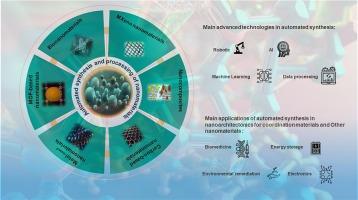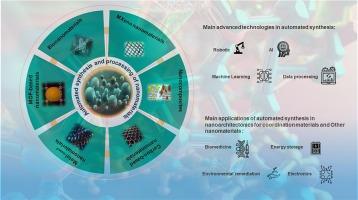Automated synthesis and processing of functional nanomaterials: Advances and perspectives
IF 20.3
1区 化学
Q1 CHEMISTRY, INORGANIC & NUCLEAR
引用次数: 0
Abstract
Integration of nanotechnology and information technology has seen an enormous leap in growth with the invention of automated systems capable of synthesizing and processing nanomaterials, thus presenting notable advantages over traditional techniques, particularly improved accuracy, reproducibility, and scalability. Automated systems minimize human errors, and nanomaterials can also be produced on a large scale at a speedy rate while controlling material properties in great detail, hence giving rise to specific functionalities that may not be realized through manual methods. Here, the most recent advancements in automated synthesis and processing of nanomaterials will be discussed, covering various types of nanomaterials which can be categorized as either coordinated or non-coordinated including metal-organic frameworks (MOFs), MXenes, quantum dots (QDs), nanocomposites, carbon-based nanomaterials, and others. Additionally, we will address the technological breakthroughs that have led to automation, from microfluidic synthesis to robots coupled with artificial intelligence (AI) and machine learning. In a new age of synthetic approaches, advanced developments within automation provide the controllable and predictable production of high-quality known nanomaterials while also providing the catalyst for generating novel nanomaterials. The primary object of this review is to provide a comprehensive and critical assessment of the current trends and breakthroughs in automated nanomaterial synthesis and processing, which brings out the research principles and the advantages of different automated platforms. It is equally important to address some limitations of current approaches to ignite a discussion about future research directions.


功能纳米材料的自动合成和加工:进展与前景
随着能够合成和加工纳米材料的自动化系统的发明,纳米技术与信息技术的结合出现了巨大的飞跃,从而与传统技术相比具有显著的优势,特别是提高了准确性、可重复性和可扩展性。自动化系统最大程度地减少了人为误差,还可以快速大规模地生产纳米材料,同时详细控制材料特性,从而实现人工方法可能无法实现的特定功能。在此,我们将讨论纳米材料自动化合成和加工的最新进展,涵盖各类配位或非配位纳米材料,包括金属有机框架 (MOF)、MXenes、量子点 (QD)、纳米复合材料、碳基纳米材料等。此外,我们还将讨论实现自动化的技术突破,从微流控合成到机器人与人工智能(AI)和机器学习的结合。在合成方法的新时代,自动化领域的先进发展为高质量的已知纳米材料的生产提供了可控性和可预测性,同时也为新型纳米材料的产生提供了催化剂。本综述的主要目的是对当前自动化纳米材料合成与加工的趋势和突破进行全面、批判性的评估,从而揭示不同自动化平台的研究原理和优势。同样重要的是探讨当前方法的一些局限性,从而引发对未来研究方向的讨论。
本文章由计算机程序翻译,如有差异,请以英文原文为准。
求助全文
约1分钟内获得全文
求助全文
来源期刊

Coordination Chemistry Reviews
化学-无机化学与核化学
CiteScore
34.30
自引率
5.30%
发文量
457
审稿时长
54 days
期刊介绍:
Coordination Chemistry Reviews offers rapid publication of review articles on current and significant topics in coordination chemistry, encompassing organometallic, supramolecular, theoretical, and bioinorganic chemistry. It also covers catalysis, materials chemistry, and metal-organic frameworks from a coordination chemistry perspective. Reviews summarize recent developments or discuss specific techniques, welcoming contributions from both established and emerging researchers.
The journal releases special issues on timely subjects, including those featuring contributions from specific regions or conferences. Occasional full-length book articles are also featured. Additionally, special volumes cover annual reviews of main group chemistry, transition metal group chemistry, and organometallic chemistry. These comprehensive reviews are vital resources for those engaged in coordination chemistry, further establishing Coordination Chemistry Reviews as a hub for insightful surveys in inorganic and physical inorganic chemistry.
 求助内容:
求助内容: 应助结果提醒方式:
应助结果提醒方式:


